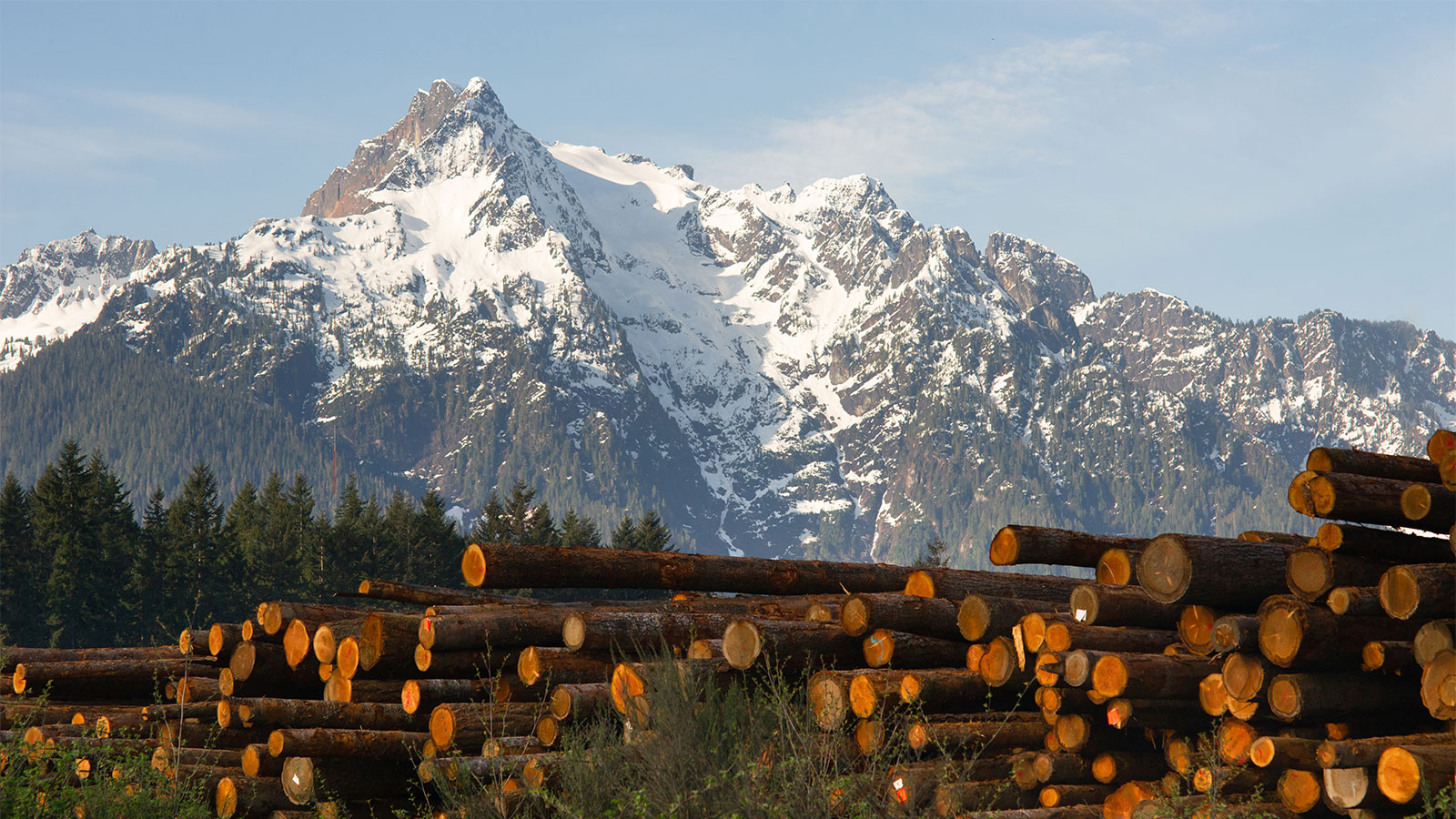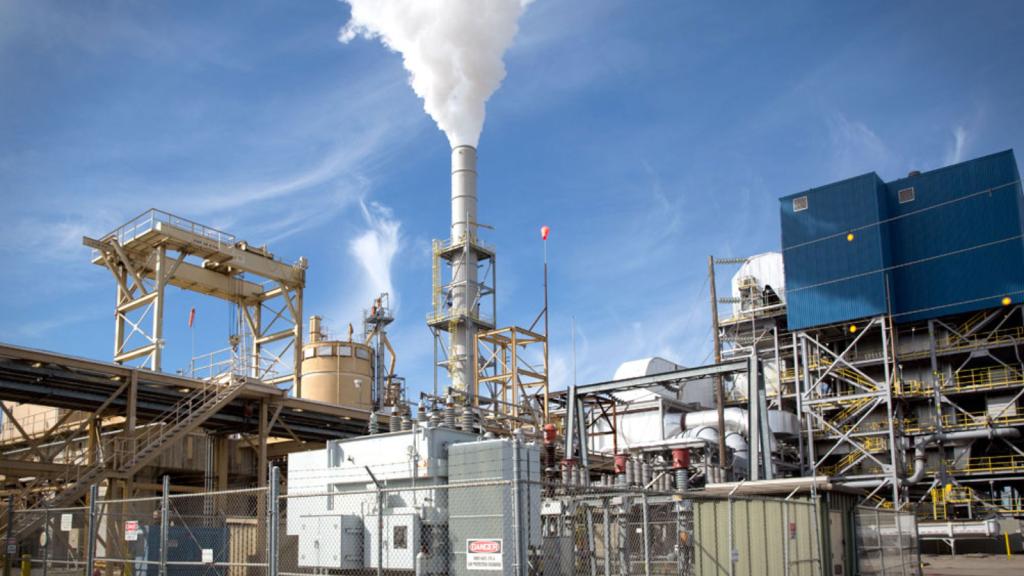The drive from Seattle into the Cascade mountains quickly plunges into dense, green tunnels of evergreen forest — and just as rapidly, reveals patches where the forest has been cleared. Nestled among the trees is the small town of Darrington. A church welcomes visitors with a sign made from a saw blade. Its high school mascot is “the Logger.” And for more than a century, its residents’ lifeblood has been timber.
Logging has put Darrington squarely on the frontlines of rural conservation battles. Things reached a low point in the early 1990s, when environmentalists and timber companies fought over how much, if any, logging should take place on federal forests. Then, in 1994, the federal government quickly passed the Northwest Forest Plan, covering over 24 million acres in Washington, Oregon, and Northern California. The largest forest and ecosystem management plan in the nation, the policy has safeguarded streams, salmon, and old-growth forests — now crucial for climate change mitigation. Since then, very little management has taken place on federal forest land in Washington. Forests have grown too dense, becoming unhealthy and susceptible to catastrophic wildfire.
And communities like Darrington suffered. As logging dwindled, residents left for jobs and amenities elsewhere, and businesses closed. Today, the population hovers around 1,100 people, and the median income is around $37,000 per year. The majority of people with jobs have to commute out of the area, often for more than an hour.
As the Northwest Forest Plan gets updated this year, community-based groups like the Darrington Collaborative are working to show how conservation can more successfully co-exist with rural communities. They hope to find new solutions for other towns surrounded by federal forest land.
Collaboration is crucial
The Darrington Collaborative formed in 2015 to modernize ecological practices and innovate in ways that wouldn’t leave anyone behind. Its ten members include representatives from timber companies and environmental groups like The Wilderness Society, as well as key civic leaders like Darrington mayor Dan Rankin. Since then, the group has launched multiple demonstration projects. Each shows how management techniques can work in practice — like restoration thinning, which involves managers helping forests become more diverse and clearing space for remaining trees to grow.
When the collaboration began, Mayor Rankin said building trust took real time. “We’re 25 years out of the Northwest Forest Plan, and we were called traitors,” he said. “It was nasty. But we prevailed.” He said the group has focused on projects that can simultaneously bring timber to market, provide jobs, and restore the forest.
The team’s first step was to get to know each other and figure out commonalities. Next, they wanted to test those areas of agreement in places that weren’t currently hosting critical wildlife species. The first two pilot projects, named Segelsen 1 and Segelsen 2, involved analyzing and thinning on 70-acre sections of forest. Both were full of Western hemlock and Douglas fir trees all about the same age and size that shaded out the understory.
The goal was to make a healthier forest, with some open areas, and some places where trees grew densely, similar to a natural landscape. The Segelsen 1 project was purchased by Darrington-based Hampton Lumber, while another company, Sierra Pacific Industries, bought the Segelsen 2 project.
Restoration, unlike traditional logging, focuses more on what is left behind than what is taken to the mill. This kind of forest management increases biodiversity and also makes forests more resilient to fire, said Taylor Luneau, The Wilderness Society’s Western North Cascades conservation manager.
“When you’ve reduced those small trees that act as ladder fuels,” or vegetation that allows a fire to climb upward from the forest floor, “you can get through a fire more sustainably,” Luneau said. This helps develop a diverse mix of small and large trees more similar to an old-growth forest, creating an ecosystem that supports wildlife habitat. “You’ve got a win-win right there, where you’re taking timber out of the forest, and you’re doing it in an ecologically sound way,” he said.
Hampton Lumber, which currently employs 175 people at its Darrington mill, supported the Segelsen projects. Tim Johnson, the Washington regional manager for the company, is part of the Darrington Collaborative. “[Thinning is] out of the ordinary for our company,” he said. “It takes a lot more effort. It’s harder to log, and it’s a little bit higher cost.” But if that’s what they need to do to bring money into the area and get wood out of overly dense federal forests, Johnson adds, Hampton is willing.
The town’s government has stayed very involved. Mayor Rankin, who co-chairs the Collaborative, has been visiting the project sites each year. “The way the landscape responded was perfect,” he said. “It brought the complexity of that landscape to a different level that we didn’t anticipate.” Sunlight now shines through to the forest floor, and shrubs and other plant life have begun to grow below.
Now, animals like deer, bobcats, and squirrels are using these sections of forest, along with birds. “You can see where that trajectory is going,” Rankin said, “and it’s pretty reassuring that, ‘Hey, we did it right.’”
Along the way, the members of the Collaborative have found they share more common ground than they expected, said member Megan Birzell, Washington state director for The Wilderness Society.
“When conservation and timber don’t talk to each other, there’s a perception that loggers and rural people don’t care about the environment and conservationists don’t care about people,” Birzell said. “That’s absolutely not true. There are things we’re never going to agree on, but on the 80% we do agree on, we can actually get a lot done—and we build trust that allows us to increase that zone of agreement.”
Seeding hope
In March of 2014, the Oso landslide seven miles outside town became the deadliest in U.S. history, killing 43 people. After the tragedy, Darrington found itself searching for new solutions that aimed to minimize environmental damage.
The hope is that the Darrington Collaborative’s efforts will lead to more wood available for local communities to support existing sawmills as well as new economic opportunities. In 2020, the city government proposed the Darrington Wood Innovation Center, to pursue a new construction technique called mass timber. It involves nailing or gluing wood panels together to generate a strength approaching that of concrete, albeit with a much lower carbon footprint.
Federal and state governments awarded the town up to $120 million to be a “one-stop shop” for the forest-based construction material. Its first phase involves a trial to create the material, followed by an expansion into modular construction using mass timber, and eventually maybe even a sawmill that would produce the material at scale.
The project could someday provide up to 120 jobs, including not only highly-skilled positions for engineers and architects, but also entry-level positions, said Rankin. “It could make a huge difference in encouraging young people to stay in Darrington,” he added. Watching high school students graduate is always exciting, he said. But “it’s also the saddest day, because you know the next stage of their life probably isn’t going to be here.” He hopes providing more jobs for young people might be part of the solution.
Unlocking more from the outdoors
In the meantime, Darrington hopes to capitalize on another major economic driver: outdoor recreation. The picturesque area is a natural jumping-off point for adventurous types coming from Seattle. It’s close to rivers, glaciers, waterfalls, and the mountains.

The town sits near a daredevil mountain bike network that offers sweeping views of Mt. Baker. It’s also close to a famed rock climbing area, Three O’Clock Rock in the Boulder River Wilderness. And for hikers, the Mount Baker-Snoqualmie National Forest offers trailheads that lead to crowd-pleasing spots like Glacier Peak and Granite Falls.
Yet — mirroring national trends — teachers reported that many local kids were barely spending time outdoors. Darrington’s young people weren’t benefitting from these wilderness opportunities or their economic potential. So after the Oso landslide, Oak Rankin, Mayor Rankin’s nephew, helped found the Glacier Peak Institute. The institute offers 500 in-school and afterschool programs per year that expose participants to hiking, rafting, canoeing, foraging, navigation, wilderness survival, wilderness first aid, and planting trees.
“Multiple kids who’ve gone through the program are now continuing their education in areas like fisheries management and outdoor guiding,” Oak Rankin said.
He says the next step is to develop more locally-owned companies, to ensure that tourism dollars stay in the community. Progress is already being made in that direction: After years of revolving-door restaurants that would close for the winter—or sometimes forever—Darrington now supports three consistent food establishments and a new brewery, River Time Brewing. They help give the town a sense of year-round life.
That gives everyone from Mayor Rankin to environmental leaders like Luneau hope. To be truly sustainable, “we need to consider what the needs are of the local community,” Luneau said. “That’s likely going to include some level of timber harvest. But it’s also going to entail Darrington investing in its outdoor recreation infrastructure. There’s so much that could be done, and I’m really excited to see where Darrington takes things in the future.”
The Wilderness Society has been working since 1935 on uniting people to protect America’s wild places. With more than one million members and supporters, The Wilderness Society has led the effort to permanently protect nearly 112 million acres of wilderness in 44 states and ensure sound management of public lands. We believe that public lands can and should be a critical part of the solution to the climate crisis and a healthy future for all. We work to rapidly and fairly phase out fossil fuel development, responsibly ramp up renewable energy development, and protect and restore natural carbon sinks – like old-growth forests – on public lands and waters.




